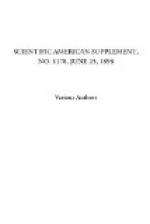The principal activity of invention in the field of reclaiming rubber dates from 1870, since which year 37 patents have been granted for processes more or less distinctive from those which had for their object only the devulcanization of rubber. Prior to that time the use of rubber reclaimed from fibrous wastes had been confined practically to one large factory in Boston and one near New York. One concern, for a while, bought old rubber shoes and sent them to women in the country, whom they paid so much a pound for the rubber stripped off—a very expensive process. There were several claimants for priority in the matter of reclaiming rubber by the processes which finally became standard, and some conflicting interests were brought together under the head of the Chemical Rubber Company. This corporation controlled the leading patents for the “acid” process, licensing various parties to work under them, and bringing suits against concerns who reclaimed rubber without their license. In 1895 the United States courts decided in favor of the defendants, practically rendering the patents invalid, on the ground that the inventions claimed under them had been disclosed by the Hall patents of 1858 and the Hayward patent of 1863.
The two patents upon which the suits for infringement rested principally were No. 249,970, granted to N.C. Mitchell, in 1881, and No. 300,720, granted to the same, in 1884. About the same time the Rubber Reclaiming Company, formed in 1890 by the combination of five leading rubber reclaiming plants, and working under license from the company above named, was resolved into the original elements. There were about that time five other rubber reclaiming plants in the United States, operating either the “acid” or the “mechanical” process, besides nine general rubber factories producing their own reclaimed rubber by the “acid” process. While several of the latter—rubber shoe concerns controlled by the United States Rubber Company—have been consolidated, there has been an increase in the number of rubber manufacturers reclaiming their own rubber, since the end of the patent litigation, so that the total number of reclaiming plants now probably is twenty.
The first step in any process for reclaiming rubber is the grinding of the waste, for which purpose several machines have been designed specially, an early patent for disintegrating rubber scrap by “subjecting it to the abrading action of grindstones” having failed to meet with favor. The most usual chemical treatment is a bath in a solution of sulphuric acid in lead-lined tanks. Generally heat is employed to hasten the process, through the medium of steam, in which case the tanks are tightly closed. The next step is the washing of the scrap, to free it of acid and dirt, after which it is sheeted by being run between iron rollers and hung in drying rooms. As soon as it has become dry it is ready for sale.




